Project Report: Analyzing Equality and Diversity at Argos Ltd.
VerifiedAdded on 2023/01/19
|23
|5262
|58
Report
AI Summary
This report provides a comprehensive analysis of equality and diversity within Argos Ltd., a major UK retailer. The project begins with an introduction highlighting the importance of diversity in today's globalized business environment, followed by the project's aims and objectives, which include identifying challenges and evaluating strategies for managing diversity. A detailed project management plan is presented, outlining costs, timelines, and resources. The report includes a Work Breakdown Structure (WBS) and a Gantt chart for project management, alongside a small-scale research component that utilizes both qualitative and quantitative research methods, including questionnaires, to gather data from stakeholders. The research focuses on understanding the challenges and benefits of workplace diversity, such as cultural differences, communication barriers, and the promotion of innovation. The findings are presented using appropriate tools and techniques, leading to a conclusion that summarizes the key insights and recommendations for Argos Ltd. to effectively manage equality and diversity. The report also includes references to support the research and findings.
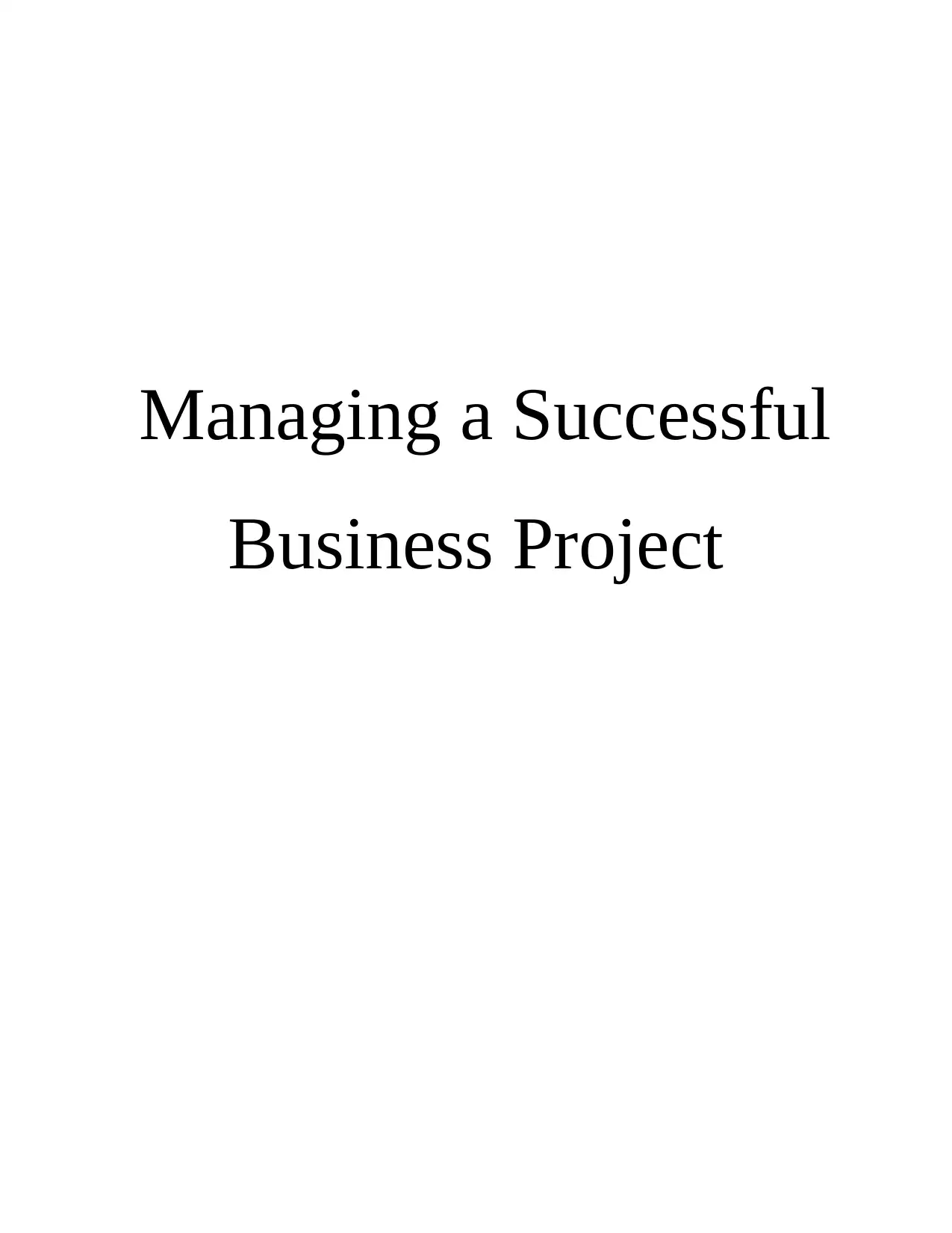
Managing a Successful
Business Project
Business Project
Paraphrase This Document
Need a fresh take? Get an instant paraphrase of this document with our AI Paraphraser
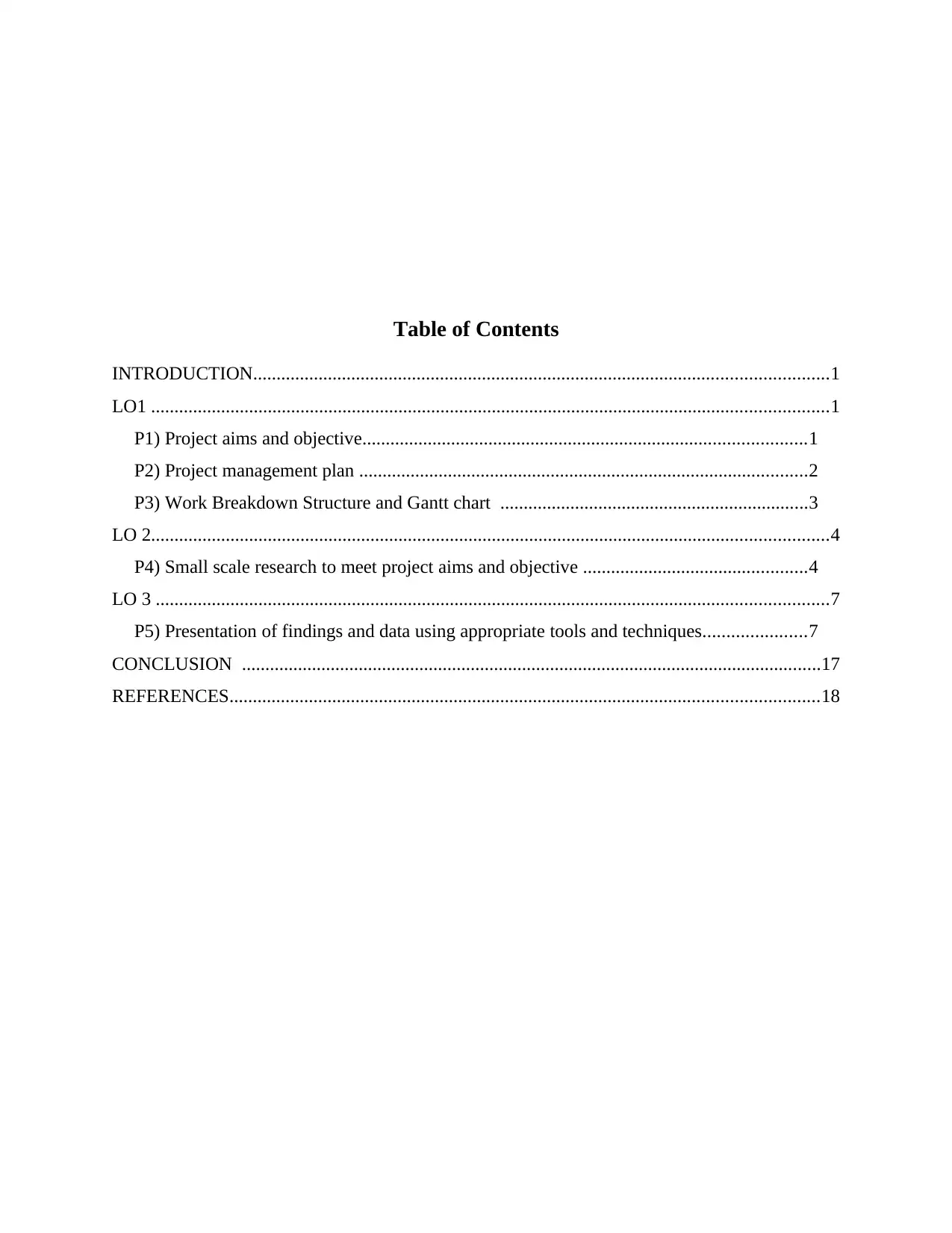
Table of Contents
INTRODUCTION...........................................................................................................................1
LO1 .................................................................................................................................................1
P1) Project aims and objective...............................................................................................1
P2) Project management plan ................................................................................................2
P3) Work Breakdown Structure and Gantt chart ..................................................................3
LO 2.................................................................................................................................................4
P4) Small scale research to meet project aims and objective ................................................4
LO 3 ................................................................................................................................................7
P5) Presentation of findings and data using appropriate tools and techniques......................7
CONCLUSION ............................................................................................................................17
REFERENCES..............................................................................................................................18
INTRODUCTION...........................................................................................................................1
LO1 .................................................................................................................................................1
P1) Project aims and objective...............................................................................................1
P2) Project management plan ................................................................................................2
P3) Work Breakdown Structure and Gantt chart ..................................................................3
LO 2.................................................................................................................................................4
P4) Small scale research to meet project aims and objective ................................................4
LO 3 ................................................................................................................................................7
P5) Presentation of findings and data using appropriate tools and techniques......................7
CONCLUSION ............................................................................................................................17
REFERENCES..............................................................................................................................18
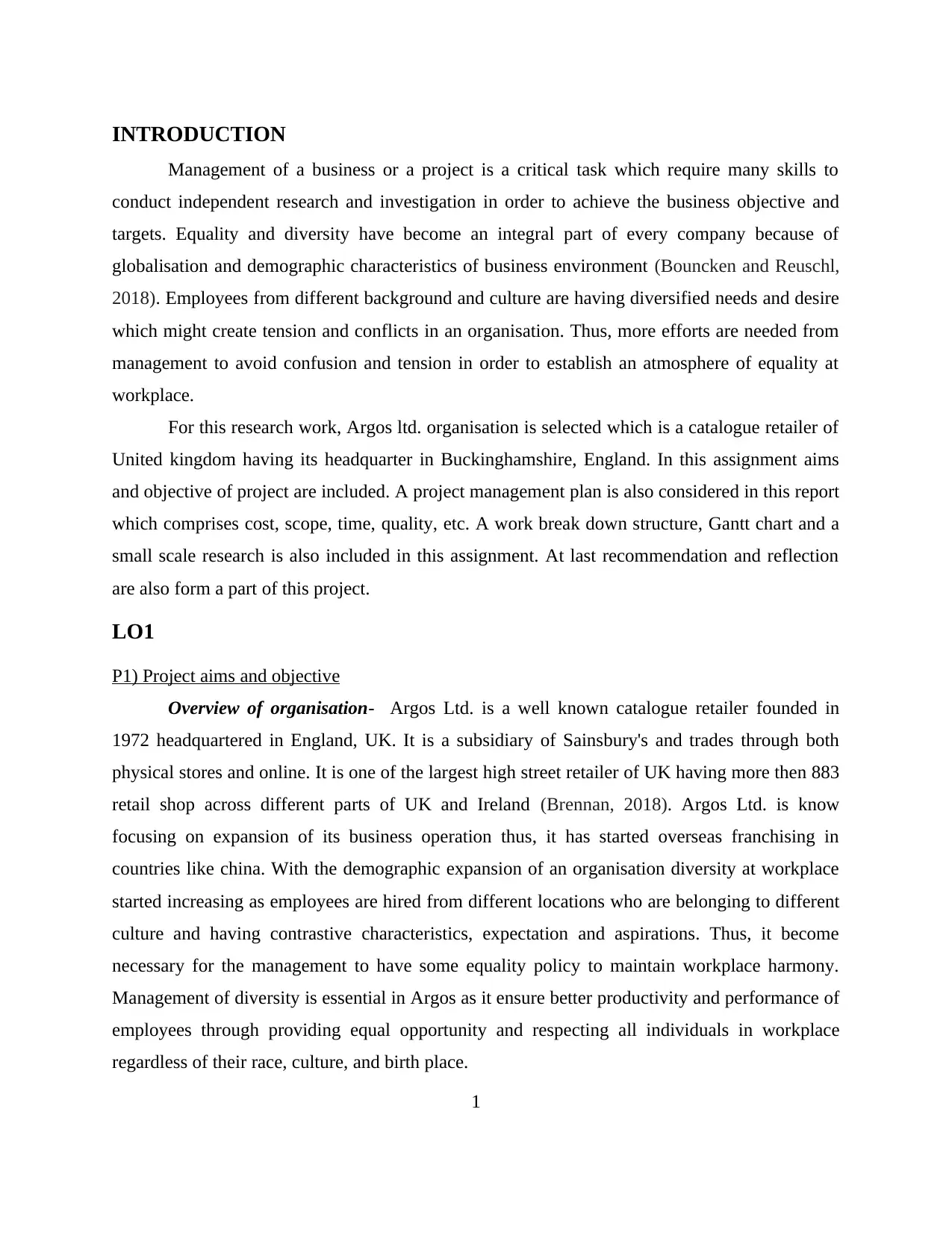
INTRODUCTION
Management of a business or a project is a critical task which require many skills to
conduct independent research and investigation in order to achieve the business objective and
targets. Equality and diversity have become an integral part of every company because of
globalisation and demographic characteristics of business environment (Bouncken and Reuschl,
2018). Employees from different background and culture are having diversified needs and desire
which might create tension and conflicts in an organisation. Thus, more efforts are needed from
management to avoid confusion and tension in order to establish an atmosphere of equality at
workplace.
For this research work, Argos ltd. organisation is selected which is a catalogue retailer of
United kingdom having its headquarter in Buckinghamshire, England. In this assignment aims
and objective of project are included. A project management plan is also considered in this report
which comprises cost, scope, time, quality, etc. A work break down structure, Gantt chart and a
small scale research is also included in this assignment. At last recommendation and reflection
are also form a part of this project.
LO1
P1) Project aims and objective
Overview of organisation- Argos Ltd. is a well known catalogue retailer founded in
1972 headquartered in England, UK. It is a subsidiary of Sainsbury's and trades through both
physical stores and online. It is one of the largest high street retailer of UK having more then 883
retail shop across different parts of UK and Ireland (Brennan, 2018). Argos Ltd. is know
focusing on expansion of its business operation thus, it has started overseas franchising in
countries like china. With the demographic expansion of an organisation diversity at workplace
started increasing as employees are hired from different locations who are belonging to different
culture and having contrastive characteristics, expectation and aspirations. Thus, it become
necessary for the management to have some equality policy to maintain workplace harmony.
Management of diversity is essential in Argos as it ensure better productivity and performance of
employees through providing equal opportunity and respecting all individuals in workplace
regardless of their race, culture, and birth place.
1
Management of a business or a project is a critical task which require many skills to
conduct independent research and investigation in order to achieve the business objective and
targets. Equality and diversity have become an integral part of every company because of
globalisation and demographic characteristics of business environment (Bouncken and Reuschl,
2018). Employees from different background and culture are having diversified needs and desire
which might create tension and conflicts in an organisation. Thus, more efforts are needed from
management to avoid confusion and tension in order to establish an atmosphere of equality at
workplace.
For this research work, Argos ltd. organisation is selected which is a catalogue retailer of
United kingdom having its headquarter in Buckinghamshire, England. In this assignment aims
and objective of project are included. A project management plan is also considered in this report
which comprises cost, scope, time, quality, etc. A work break down structure, Gantt chart and a
small scale research is also included in this assignment. At last recommendation and reflection
are also form a part of this project.
LO1
P1) Project aims and objective
Overview of organisation- Argos Ltd. is a well known catalogue retailer founded in
1972 headquartered in England, UK. It is a subsidiary of Sainsbury's and trades through both
physical stores and online. It is one of the largest high street retailer of UK having more then 883
retail shop across different parts of UK and Ireland (Brennan, 2018). Argos Ltd. is know
focusing on expansion of its business operation thus, it has started overseas franchising in
countries like china. With the demographic expansion of an organisation diversity at workplace
started increasing as employees are hired from different locations who are belonging to different
culture and having contrastive characteristics, expectation and aspirations. Thus, it become
necessary for the management to have some equality policy to maintain workplace harmony.
Management of diversity is essential in Argos as it ensure better productivity and performance of
employees through providing equal opportunity and respecting all individuals in workplace
regardless of their race, culture, and birth place.
1
⊘ This is a preview!⊘
Do you want full access?
Subscribe today to unlock all pages.

Trusted by 1+ million students worldwide
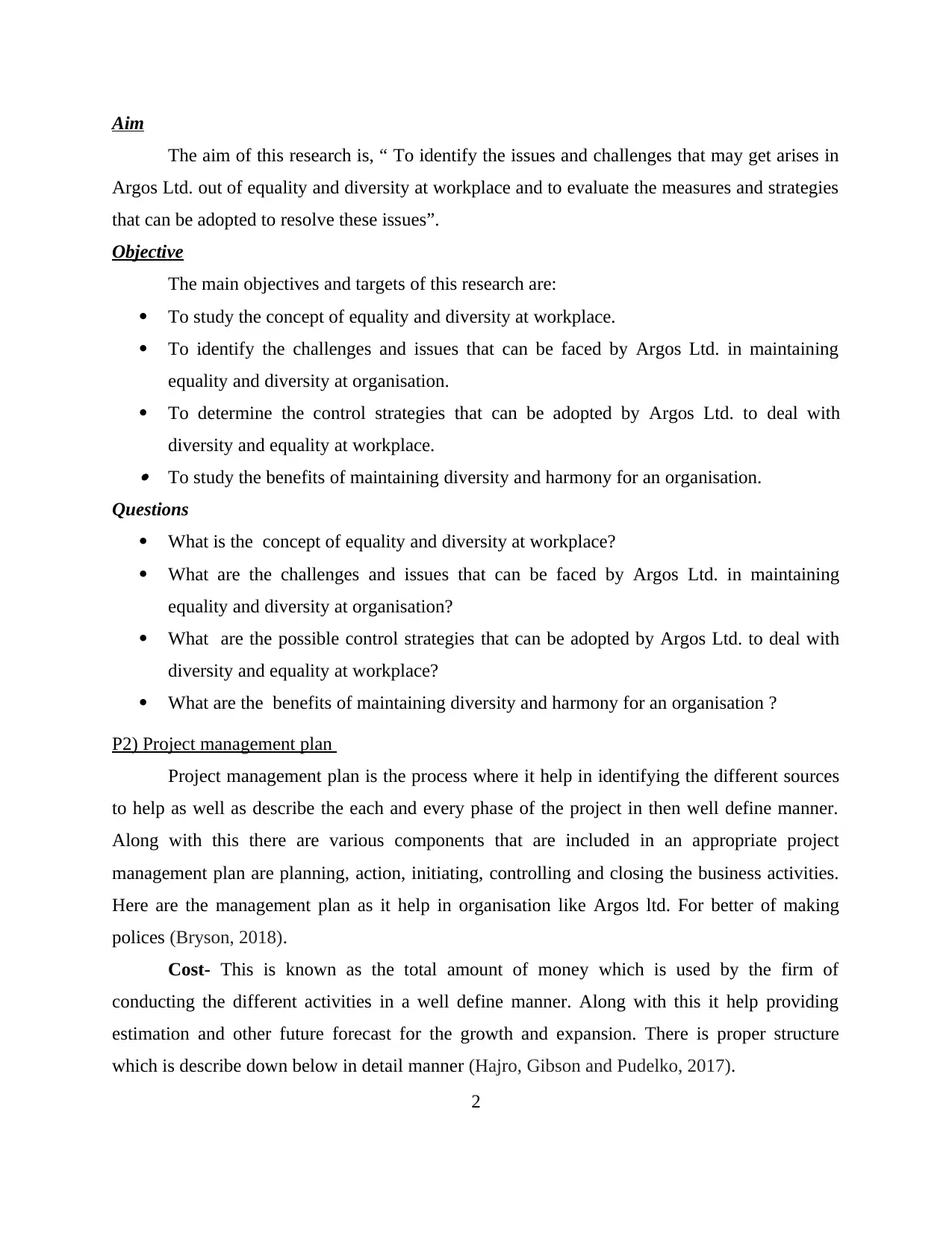
Aim
The aim of this research is, “ To identify the issues and challenges that may get arises in
Argos Ltd. out of equality and diversity at workplace and to evaluate the measures and strategies
that can be adopted to resolve these issues”.
Objective
The main objectives and targets of this research are:
To study the concept of equality and diversity at workplace.
To identify the challenges and issues that can be faced by Argos Ltd. in maintaining
equality and diversity at organisation.
To determine the control strategies that can be adopted by Argos Ltd. to deal with
diversity and equality at workplace. To study the benefits of maintaining diversity and harmony for an organisation.
Questions
What is the concept of equality and diversity at workplace?
What are the challenges and issues that can be faced by Argos Ltd. in maintaining
equality and diversity at organisation?
What are the possible control strategies that can be adopted by Argos Ltd. to deal with
diversity and equality at workplace?
What are the benefits of maintaining diversity and harmony for an organisation ?
P2) Project management plan
Project management plan is the process where it help in identifying the different sources
to help as well as describe the each and every phase of the project in then well define manner.
Along with this there are various components that are included in an appropriate project
management plan are planning, action, initiating, controlling and closing the business activities.
Here are the management plan as it help in organisation like Argos ltd. For better of making
polices (Bryson, 2018).
Cost- This is known as the total amount of money which is used by the firm of
conducting the different activities in a well define manner. Along with this it help providing
estimation and other future forecast for the growth and expansion. There is proper structure
which is describe down below in detail manner (Hajro, Gibson and Pudelko, 2017).
2
The aim of this research is, “ To identify the issues and challenges that may get arises in
Argos Ltd. out of equality and diversity at workplace and to evaluate the measures and strategies
that can be adopted to resolve these issues”.
Objective
The main objectives and targets of this research are:
To study the concept of equality and diversity at workplace.
To identify the challenges and issues that can be faced by Argos Ltd. in maintaining
equality and diversity at organisation.
To determine the control strategies that can be adopted by Argos Ltd. to deal with
diversity and equality at workplace. To study the benefits of maintaining diversity and harmony for an organisation.
Questions
What is the concept of equality and diversity at workplace?
What are the challenges and issues that can be faced by Argos Ltd. in maintaining
equality and diversity at organisation?
What are the possible control strategies that can be adopted by Argos Ltd. to deal with
diversity and equality at workplace?
What are the benefits of maintaining diversity and harmony for an organisation ?
P2) Project management plan
Project management plan is the process where it help in identifying the different sources
to help as well as describe the each and every phase of the project in then well define manner.
Along with this there are various components that are included in an appropriate project
management plan are planning, action, initiating, controlling and closing the business activities.
Here are the management plan as it help in organisation like Argos ltd. For better of making
polices (Bryson, 2018).
Cost- This is known as the total amount of money which is used by the firm of
conducting the different activities in a well define manner. Along with this it help providing
estimation and other future forecast for the growth and expansion. There is proper structure
which is describe down below in detail manner (Hajro, Gibson and Pudelko, 2017).
2
Paraphrase This Document
Need a fresh take? Get an instant paraphrase of this document with our AI Paraphraser
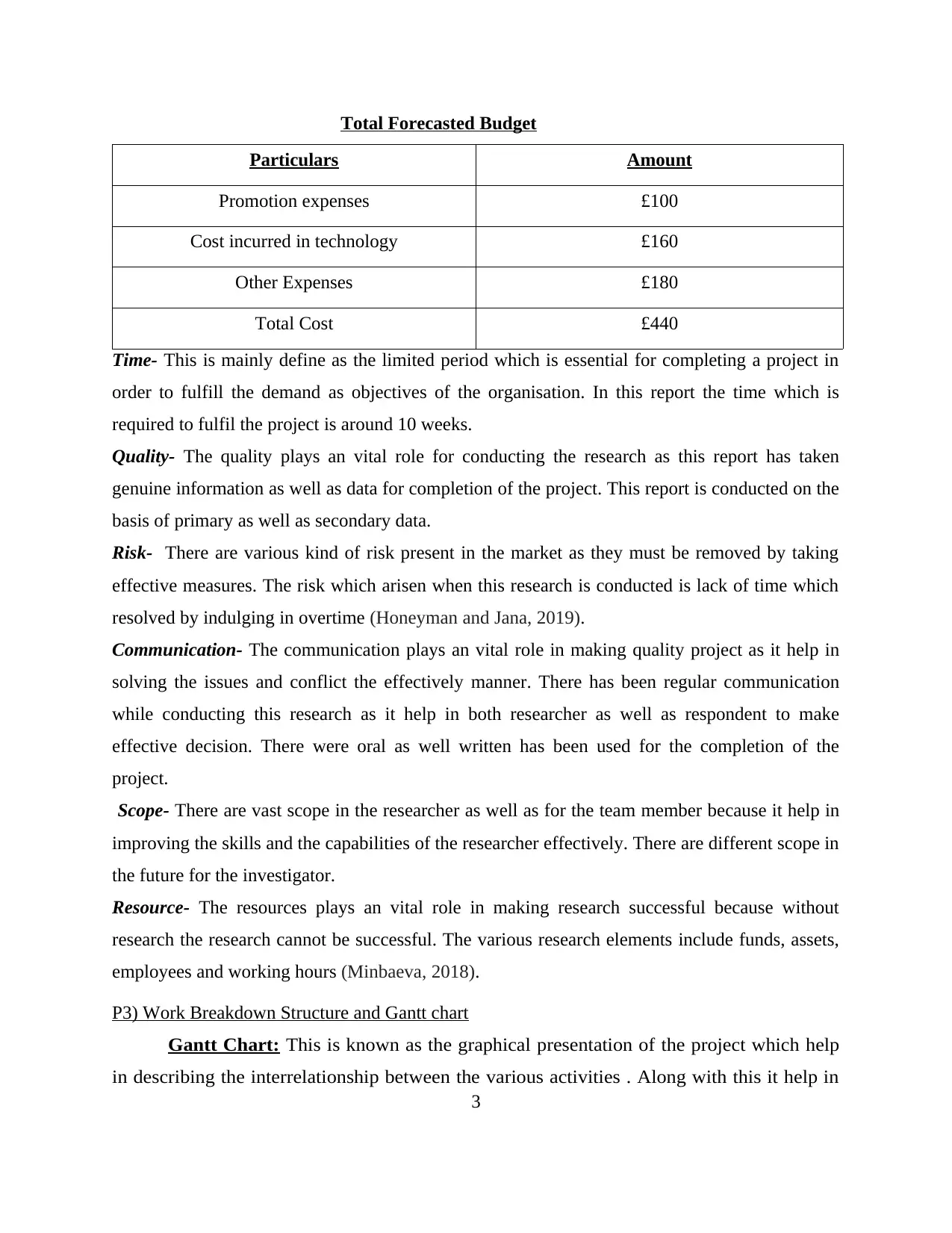
Total Forecasted Budget
Particulars Amount
Promotion expenses £100
Cost incurred in technology £160
Other Expenses £180
Total Cost £440
Time- This is mainly define as the limited period which is essential for completing a project in
order to fulfill the demand as objectives of the organisation. In this report the time which is
required to fulfil the project is around 10 weeks.
Quality- The quality plays an vital role for conducting the research as this report has taken
genuine information as well as data for completion of the project. This report is conducted on the
basis of primary as well as secondary data.
Risk- There are various kind of risk present in the market as they must be removed by taking
effective measures. The risk which arisen when this research is conducted is lack of time which
resolved by indulging in overtime (Honeyman and Jana, 2019).
Communication- The communication plays an vital role in making quality project as it help in
solving the issues and conflict the effectively manner. There has been regular communication
while conducting this research as it help in both researcher as well as respondent to make
effective decision. There were oral as well written has been used for the completion of the
project.
Scope- There are vast scope in the researcher as well as for the team member because it help in
improving the skills and the capabilities of the researcher effectively. There are different scope in
the future for the investigator.
Resource- The resources plays an vital role in making research successful because without
research the research cannot be successful. The various research elements include funds, assets,
employees and working hours (Minbaeva, 2018).
P3) Work Breakdown Structure and Gantt chart
Gantt Chart: This is known as the graphical presentation of the project which help
in describing the interrelationship between the various activities . Along with this it help in
3
Particulars Amount
Promotion expenses £100
Cost incurred in technology £160
Other Expenses £180
Total Cost £440
Time- This is mainly define as the limited period which is essential for completing a project in
order to fulfill the demand as objectives of the organisation. In this report the time which is
required to fulfil the project is around 10 weeks.
Quality- The quality plays an vital role for conducting the research as this report has taken
genuine information as well as data for completion of the project. This report is conducted on the
basis of primary as well as secondary data.
Risk- There are various kind of risk present in the market as they must be removed by taking
effective measures. The risk which arisen when this research is conducted is lack of time which
resolved by indulging in overtime (Honeyman and Jana, 2019).
Communication- The communication plays an vital role in making quality project as it help in
solving the issues and conflict the effectively manner. There has been regular communication
while conducting this research as it help in both researcher as well as respondent to make
effective decision. There were oral as well written has been used for the completion of the
project.
Scope- There are vast scope in the researcher as well as for the team member because it help in
improving the skills and the capabilities of the researcher effectively. There are different scope in
the future for the investigator.
Resource- The resources plays an vital role in making research successful because without
research the research cannot be successful. The various research elements include funds, assets,
employees and working hours (Minbaeva, 2018).
P3) Work Breakdown Structure and Gantt chart
Gantt Chart: This is known as the graphical presentation of the project which help
in describing the interrelationship between the various activities . Along with this it help in
3
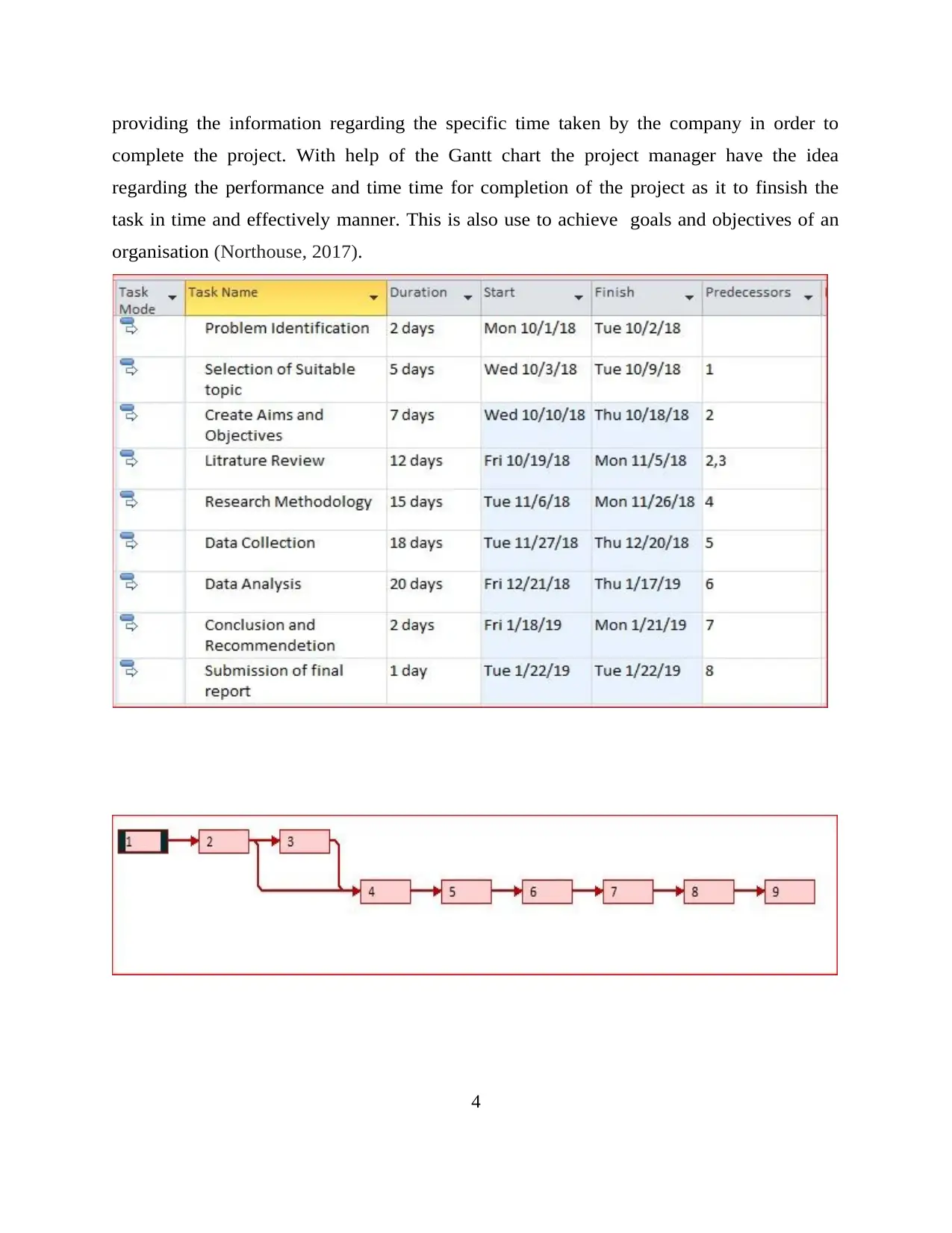
providing the information regarding the specific time taken by the company in order to
complete the project. With help of the Gantt chart the project manager have the idea
regarding the performance and time time for completion of the project as it to finsish the
task in time and effectively manner. This is also use to achieve goals and objectives of an
organisation (Northouse, 2017).
4
complete the project. With help of the Gantt chart the project manager have the idea
regarding the performance and time time for completion of the project as it to finsish the
task in time and effectively manner. This is also use to achieve goals and objectives of an
organisation (Northouse, 2017).
4
⊘ This is a preview!⊘
Do you want full access?
Subscribe today to unlock all pages.

Trusted by 1+ million students worldwide
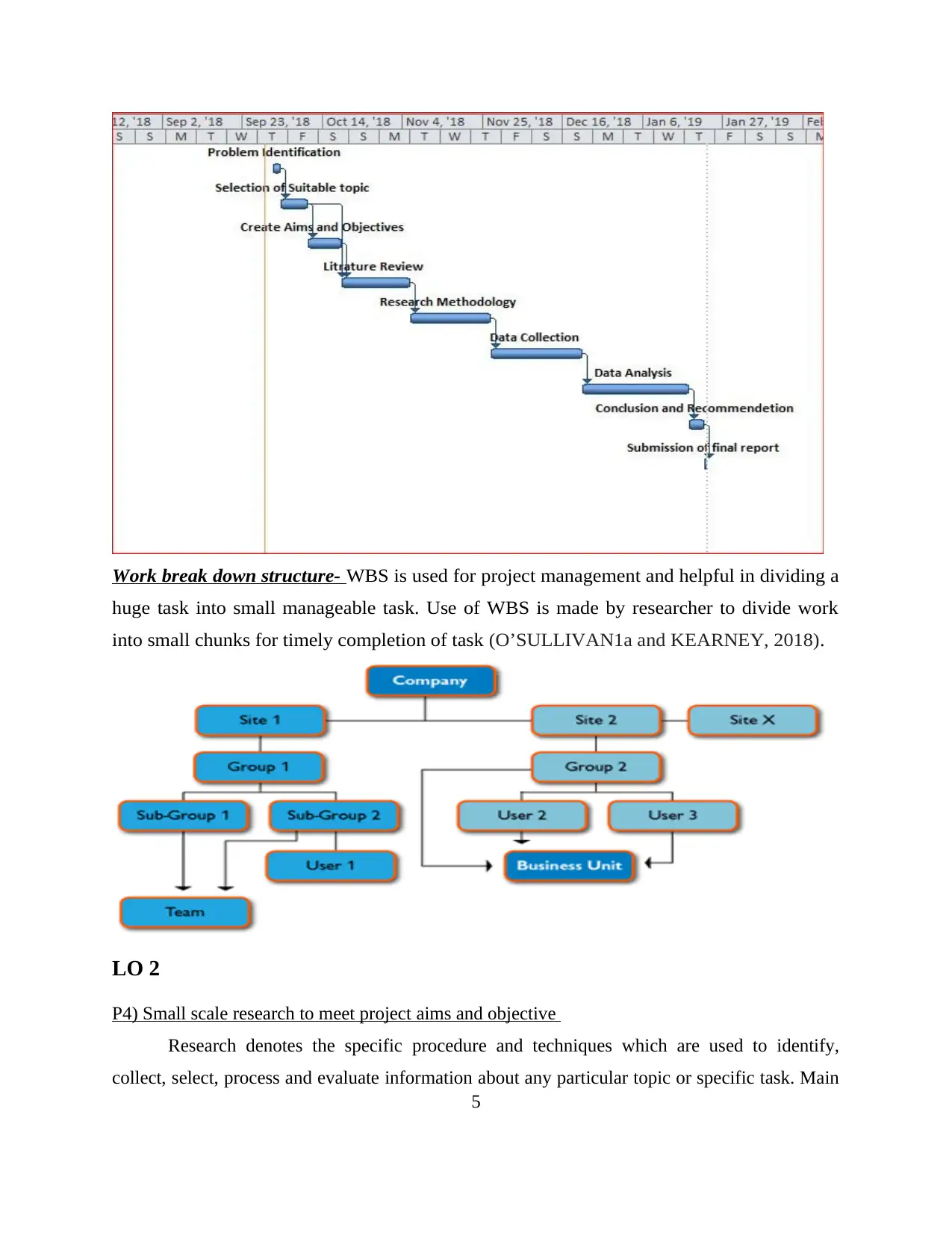
Work break down structure- WBS is used for project management and helpful in dividing a
huge task into small manageable task. Use of WBS is made by researcher to divide work
into small chunks for timely completion of task (O’SULLIVAN1a and KEARNEY, 2018).
LO 2
P4) Small scale research to meet project aims and objective
Research denotes the specific procedure and techniques which are used to identify,
collect, select, process and evaluate information about any particular topic or specific task. Main
5
huge task into small manageable task. Use of WBS is made by researcher to divide work
into small chunks for timely completion of task (O’SULLIVAN1a and KEARNEY, 2018).
LO 2
P4) Small scale research to meet project aims and objective
Research denotes the specific procedure and techniques which are used to identify,
collect, select, process and evaluate information about any particular topic or specific task. Main
5
Paraphrase This Document
Need a fresh take? Get an instant paraphrase of this document with our AI Paraphraser
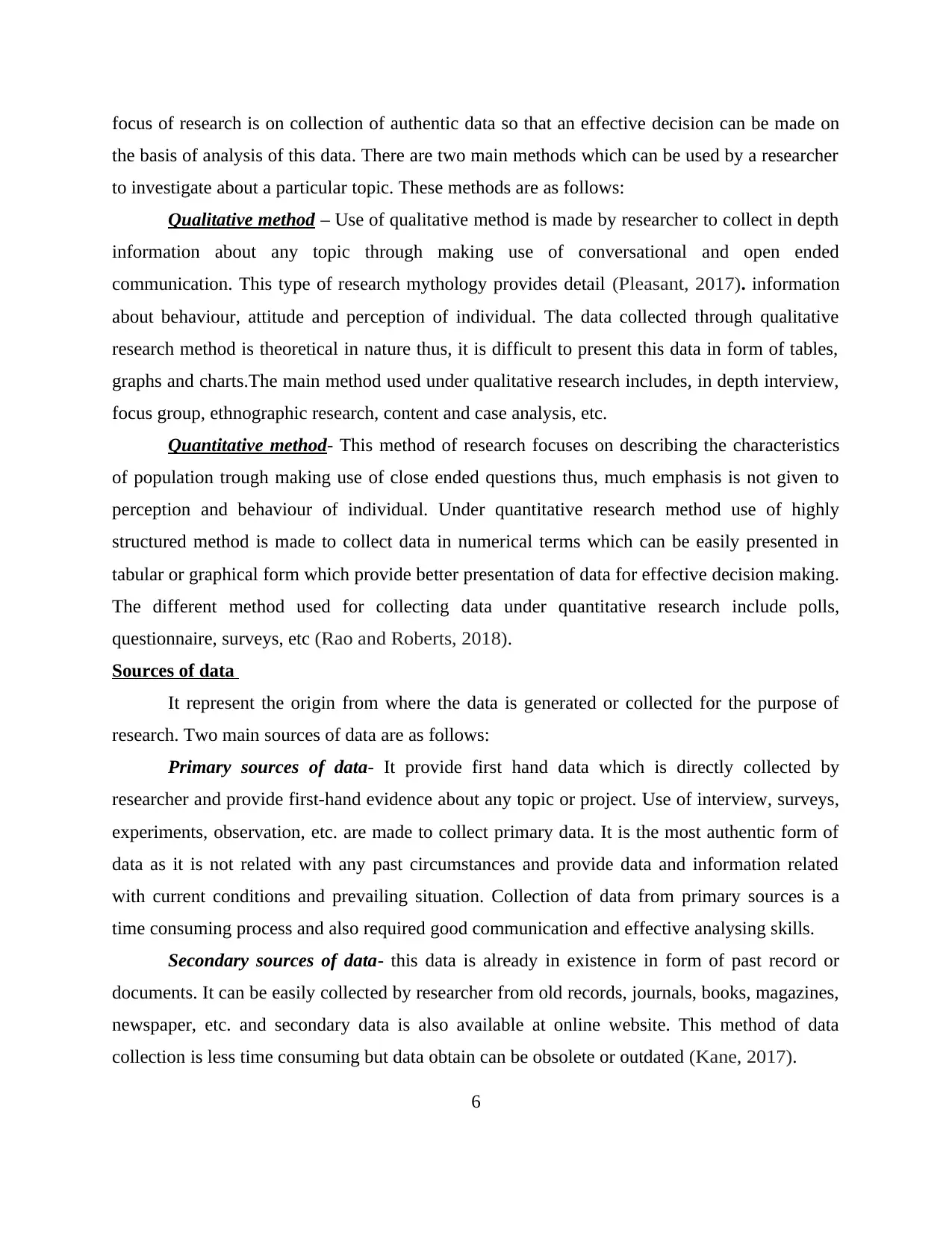
focus of research is on collection of authentic data so that an effective decision can be made on
the basis of analysis of this data. There are two main methods which can be used by a researcher
to investigate about a particular topic. These methods are as follows:
Qualitative method – Use of qualitative method is made by researcher to collect in depth
information about any topic through making use of conversational and open ended
communication. This type of research mythology provides detail (Pleasant, 2017). information
about behaviour, attitude and perception of individual. The data collected through qualitative
research method is theoretical in nature thus, it is difficult to present this data in form of tables,
graphs and charts.The main method used under qualitative research includes, in depth interview,
focus group, ethnographic research, content and case analysis, etc.
Quantitative method- This method of research focuses on describing the characteristics
of population trough making use of close ended questions thus, much emphasis is not given to
perception and behaviour of individual. Under quantitative research method use of highly
structured method is made to collect data in numerical terms which can be easily presented in
tabular or graphical form which provide better presentation of data for effective decision making.
The different method used for collecting data under quantitative research include polls,
questionnaire, surveys, etc (Rao and Roberts, 2018).
Sources of data
It represent the origin from where the data is generated or collected for the purpose of
research. Two main sources of data are as follows:
Primary sources of data- It provide first hand data which is directly collected by
researcher and provide first-hand evidence about any topic or project. Use of interview, surveys,
experiments, observation, etc. are made to collect primary data. It is the most authentic form of
data as it is not related with any past circumstances and provide data and information related
with current conditions and prevailing situation. Collection of data from primary sources is a
time consuming process and also required good communication and effective analysing skills.
Secondary sources of data- this data is already in existence in form of past record or
documents. It can be easily collected by researcher from old records, journals, books, magazines,
newspaper, etc. and secondary data is also available at online website. This method of data
collection is less time consuming but data obtain can be obsolete or outdated (Kane, 2017).
6
the basis of analysis of this data. There are two main methods which can be used by a researcher
to investigate about a particular topic. These methods are as follows:
Qualitative method – Use of qualitative method is made by researcher to collect in depth
information about any topic through making use of conversational and open ended
communication. This type of research mythology provides detail (Pleasant, 2017). information
about behaviour, attitude and perception of individual. The data collected through qualitative
research method is theoretical in nature thus, it is difficult to present this data in form of tables,
graphs and charts.The main method used under qualitative research includes, in depth interview,
focus group, ethnographic research, content and case analysis, etc.
Quantitative method- This method of research focuses on describing the characteristics
of population trough making use of close ended questions thus, much emphasis is not given to
perception and behaviour of individual. Under quantitative research method use of highly
structured method is made to collect data in numerical terms which can be easily presented in
tabular or graphical form which provide better presentation of data for effective decision making.
The different method used for collecting data under quantitative research include polls,
questionnaire, surveys, etc (Rao and Roberts, 2018).
Sources of data
It represent the origin from where the data is generated or collected for the purpose of
research. Two main sources of data are as follows:
Primary sources of data- It provide first hand data which is directly collected by
researcher and provide first-hand evidence about any topic or project. Use of interview, surveys,
experiments, observation, etc. are made to collect primary data. It is the most authentic form of
data as it is not related with any past circumstances and provide data and information related
with current conditions and prevailing situation. Collection of data from primary sources is a
time consuming process and also required good communication and effective analysing skills.
Secondary sources of data- this data is already in existence in form of past record or
documents. It can be easily collected by researcher from old records, journals, books, magazines,
newspaper, etc. and secondary data is also available at online website. This method of data
collection is less time consuming but data obtain can be obsolete or outdated (Kane, 2017).
6
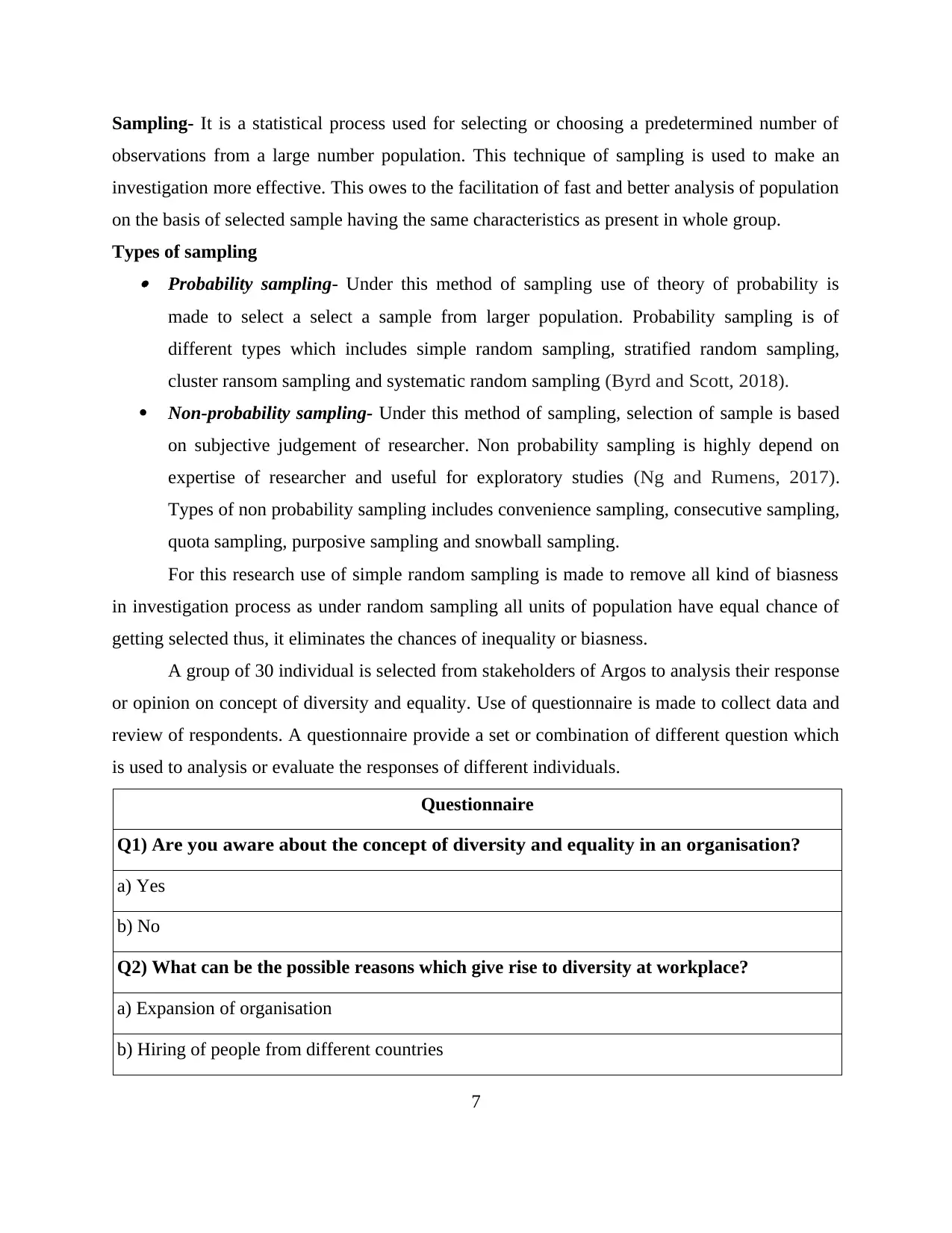
Sampling- It is a statistical process used for selecting or choosing a predetermined number of
observations from a large number population. This technique of sampling is used to make an
investigation more effective. This owes to the facilitation of fast and better analysis of population
on the basis of selected sample having the same characteristics as present in whole group.
Types of sampling Probability sampling- Under this method of sampling use of theory of probability is
made to select a select a sample from larger population. Probability sampling is of
different types which includes simple random sampling, stratified random sampling,
cluster ransom sampling and systematic random sampling (Byrd and Scott, 2018).
Non-probability sampling- Under this method of sampling, selection of sample is based
on subjective judgement of researcher. Non probability sampling is highly depend on
expertise of researcher and useful for exploratory studies (Ng and Rumens, 2017).
Types of non probability sampling includes convenience sampling, consecutive sampling,
quota sampling, purposive sampling and snowball sampling.
For this research use of simple random sampling is made to remove all kind of biasness
in investigation process as under random sampling all units of population have equal chance of
getting selected thus, it eliminates the chances of inequality or biasness.
A group of 30 individual is selected from stakeholders of Argos to analysis their response
or opinion on concept of diversity and equality. Use of questionnaire is made to collect data and
review of respondents. A questionnaire provide a set or combination of different question which
is used to analysis or evaluate the responses of different individuals.
Questionnaire
Q1) A re you aware about the concept of diversity and equality in an organisation?
a) Yes
b) No
Q2) What can be the possible reasons which give rise to diversity at workplace?
a) Expansion of organisation
b) Hiring of people from different countries
7
observations from a large number population. This technique of sampling is used to make an
investigation more effective. This owes to the facilitation of fast and better analysis of population
on the basis of selected sample having the same characteristics as present in whole group.
Types of sampling Probability sampling- Under this method of sampling use of theory of probability is
made to select a select a sample from larger population. Probability sampling is of
different types which includes simple random sampling, stratified random sampling,
cluster ransom sampling and systematic random sampling (Byrd and Scott, 2018).
Non-probability sampling- Under this method of sampling, selection of sample is based
on subjective judgement of researcher. Non probability sampling is highly depend on
expertise of researcher and useful for exploratory studies (Ng and Rumens, 2017).
Types of non probability sampling includes convenience sampling, consecutive sampling,
quota sampling, purposive sampling and snowball sampling.
For this research use of simple random sampling is made to remove all kind of biasness
in investigation process as under random sampling all units of population have equal chance of
getting selected thus, it eliminates the chances of inequality or biasness.
A group of 30 individual is selected from stakeholders of Argos to analysis their response
or opinion on concept of diversity and equality. Use of questionnaire is made to collect data and
review of respondents. A questionnaire provide a set or combination of different question which
is used to analysis or evaluate the responses of different individuals.
Questionnaire
Q1) A re you aware about the concept of diversity and equality in an organisation?
a) Yes
b) No
Q2) What can be the possible reasons which give rise to diversity at workplace?
a) Expansion of organisation
b) Hiring of people from different countries
7
⊘ This is a preview!⊘
Do you want full access?
Subscribe today to unlock all pages.

Trusted by 1+ million students worldwide
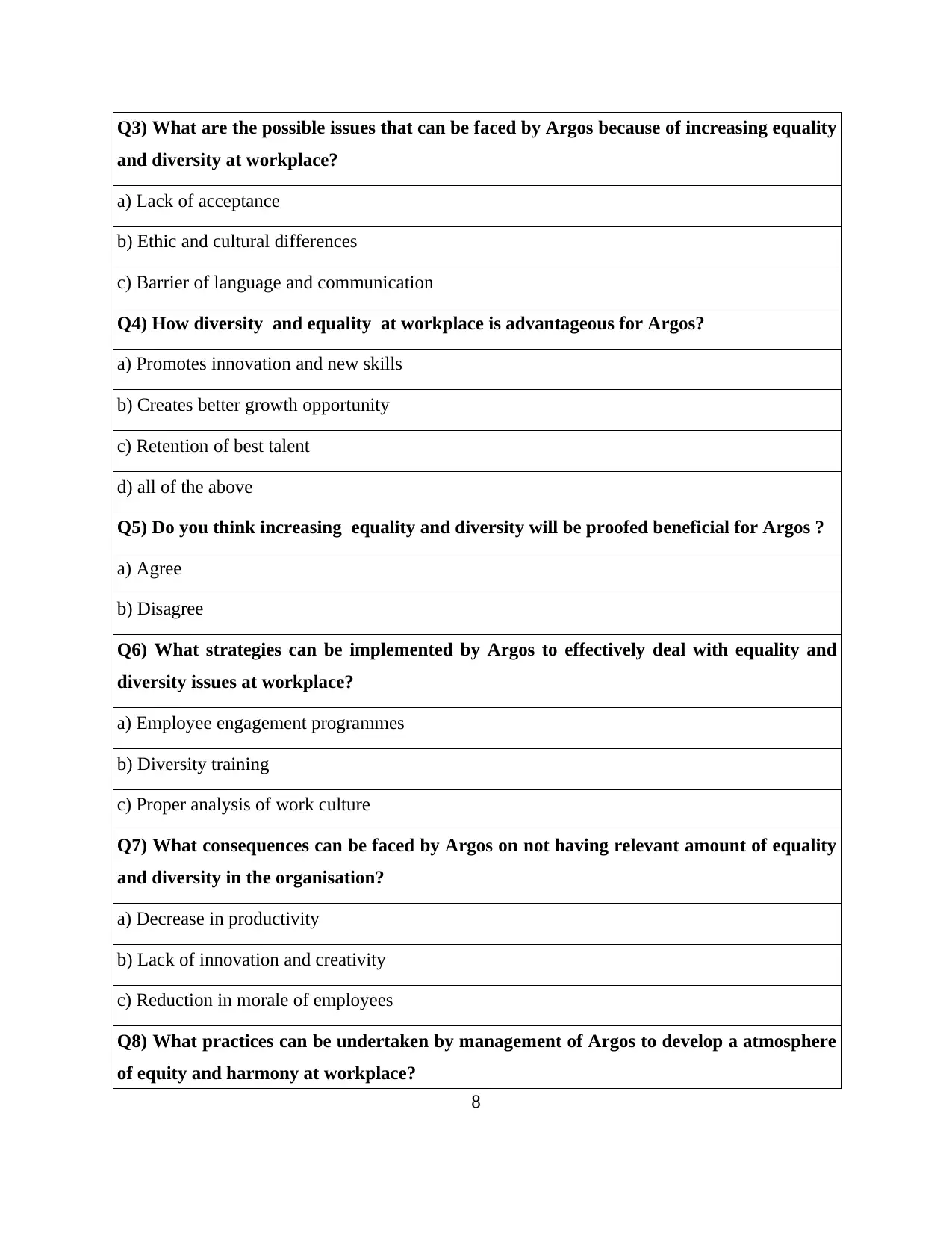
Q3) What are the possible issues that can be faced by Argos because of increasing equality
and diversity at workplace?
a) Lack of acceptance
b) Ethic and cultural differences
c) Barrier of language and communication
Q4) How diversity and equality at workplace is advantageous for Argos?
a) Promotes innovation and new skills
b) Creates better growth opportunity
c) Retention of best talent
d) all of the above
Q5) Do you think increasing equality and diversity will be proofed beneficial for Argos ?
a) Agree
b) Disagree
Q6) What strategies can be implemented by Argos to effectively deal with equality and
diversity issues at workplace?
a) Employee engagement programmes
b) Diversity training
c) Proper analysis of work culture
Q7) What consequences can be faced by Argos on not having relevant amount of equality
and diversity in the organisation?
a) Decrease in productivity
b) Lack of innovation and creativity
c) Reduction in morale of employees
Q8) What practices can be undertaken by management of Argos to develop a atmosphere
of equity and harmony at workplace?
8
and diversity at workplace?
a) Lack of acceptance
b) Ethic and cultural differences
c) Barrier of language and communication
Q4) How diversity and equality at workplace is advantageous for Argos?
a) Promotes innovation and new skills
b) Creates better growth opportunity
c) Retention of best talent
d) all of the above
Q5) Do you think increasing equality and diversity will be proofed beneficial for Argos ?
a) Agree
b) Disagree
Q6) What strategies can be implemented by Argos to effectively deal with equality and
diversity issues at workplace?
a) Employee engagement programmes
b) Diversity training
c) Proper analysis of work culture
Q7) What consequences can be faced by Argos on not having relevant amount of equality
and diversity in the organisation?
a) Decrease in productivity
b) Lack of innovation and creativity
c) Reduction in morale of employees
Q8) What practices can be undertaken by management of Argos to develop a atmosphere
of equity and harmony at workplace?
8
Paraphrase This Document
Need a fresh take? Get an instant paraphrase of this document with our AI Paraphraser
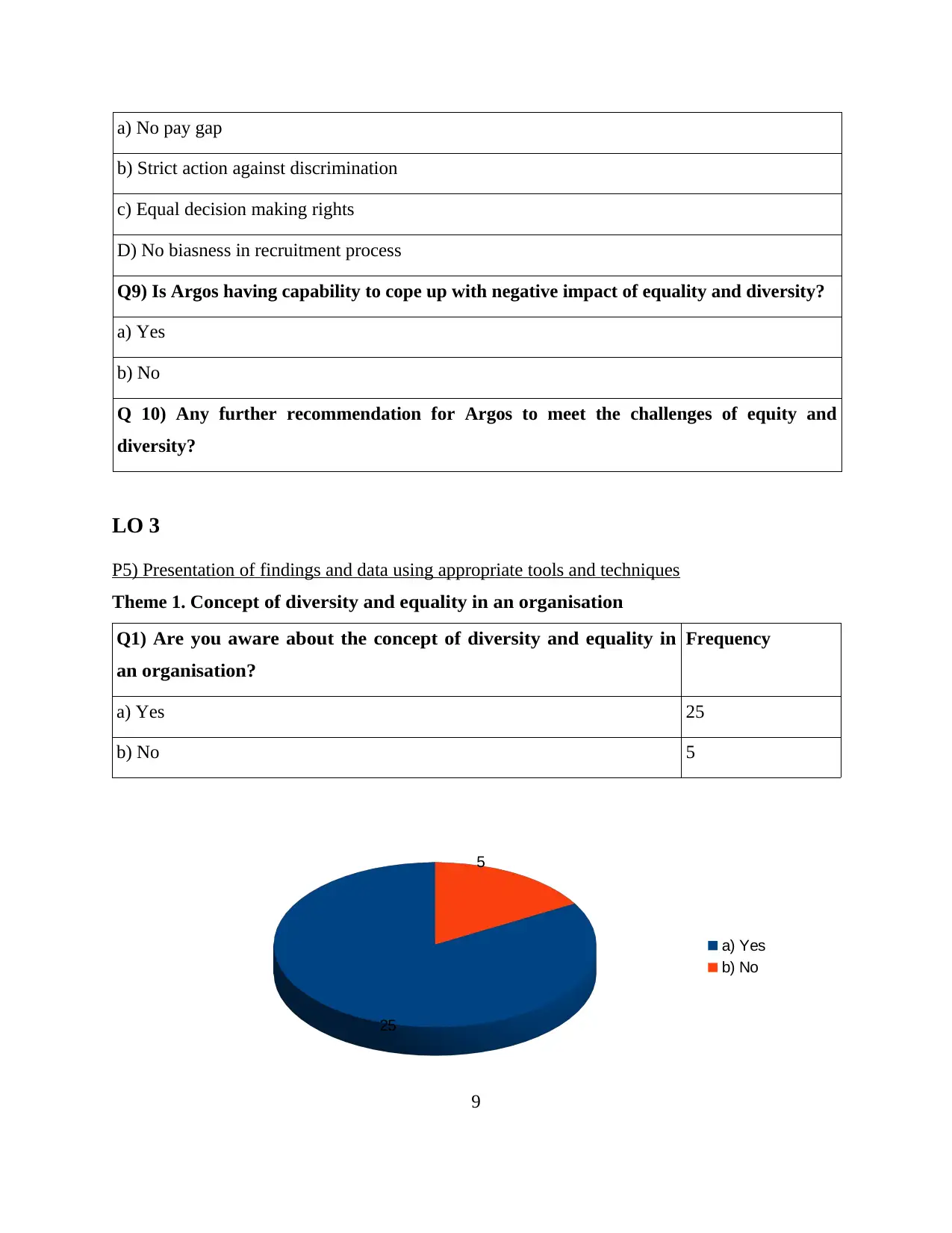
a) No pay gap
b) Strict action against discrimination
c) Equal decision making rights
D) No biasness in recruitment process
Q9) Is Argos having capability to cope up with negative impact of equality and diversity?
a) Yes
b) No
Q 10) Any further recommendation for Argos to meet the challenges of equity and
diversity?
LO 3
P5) Presentation of findings and data using appropriate tools and techniques
Theme 1. C oncept of diversity and equality in an organisation
Q1) Are you aware about the concept of diversity and equality in
an organisation?
Frequency
a) Yes 25
b) No 5
9
25
5
a) Yes
b) No
b) Strict action against discrimination
c) Equal decision making rights
D) No biasness in recruitment process
Q9) Is Argos having capability to cope up with negative impact of equality and diversity?
a) Yes
b) No
Q 10) Any further recommendation for Argos to meet the challenges of equity and
diversity?
LO 3
P5) Presentation of findings and data using appropriate tools and techniques
Theme 1. C oncept of diversity and equality in an organisation
Q1) Are you aware about the concept of diversity and equality in
an organisation?
Frequency
a) Yes 25
b) No 5
9
25
5
a) Yes
b) No
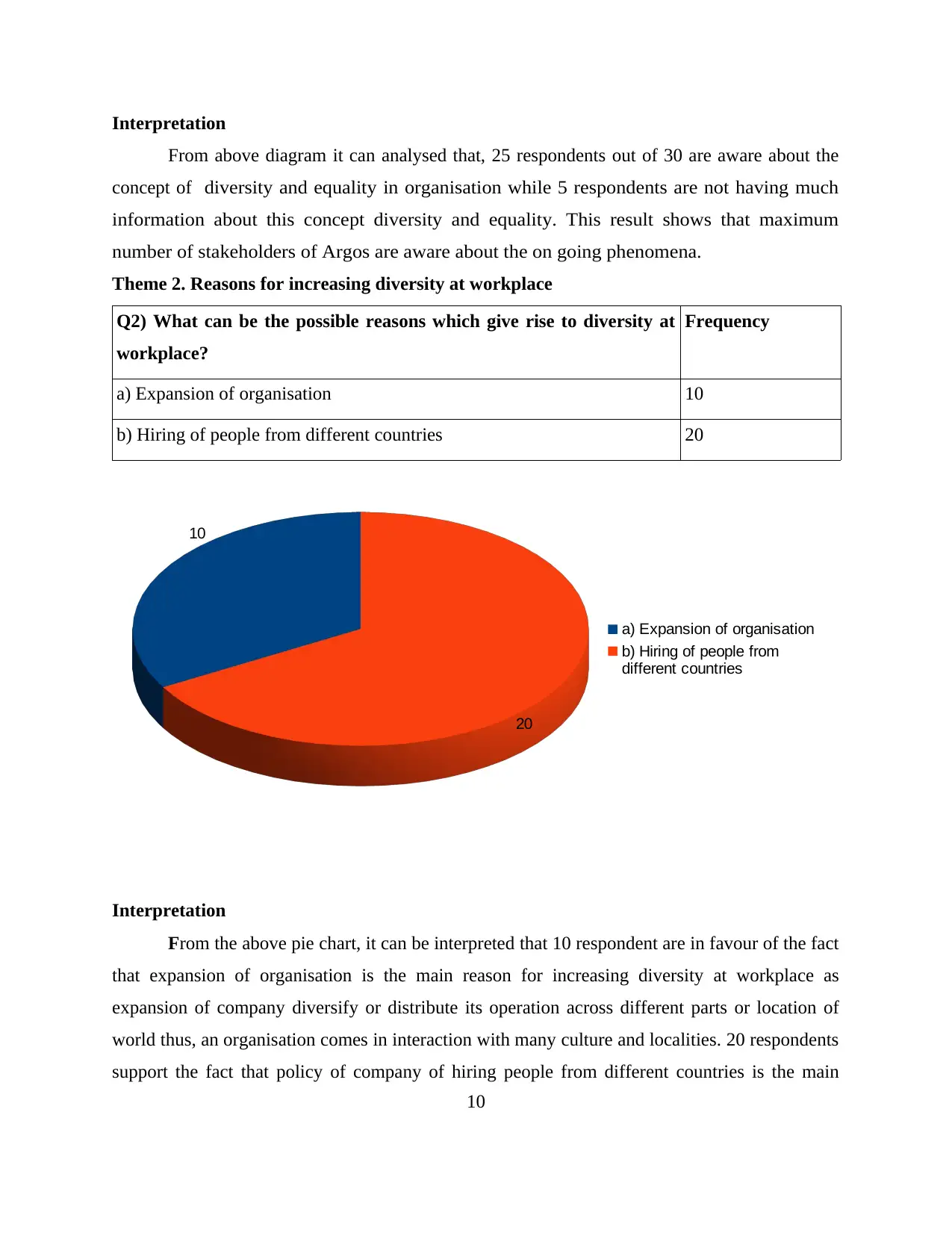
Interpretation
From above diagram it can analysed that, 25 respondents out of 30 are aware about the
concept of diversity and equality in organisation while 5 respondents are not having much
information about this concept diversity and equality. This result shows that maximum
number of stakeholders of Argos are aware about the on going phenomena.
Theme 2. Reasons for increasing diversity at workplace
Q2) What can be the possible reasons which give rise to diversity at
workplace?
Frequency
a) Expansion of organisation 10
b) Hiring of people from different countries 20
Interpretation
From the above pie chart, it can be interpreted that 10 respondent are in favour of the fact
that expansion of organisation is the main reason for increasing diversity at workplace as
expansion of company diversify or distribute its operation across different parts or location of
world thus, an organisation comes in interaction with many culture and localities. 20 respondents
support the fact that policy of company of hiring people from different countries is the main
10
10
20
a) Expansion of organisation
b) Hiring of people from
different countries
From above diagram it can analysed that, 25 respondents out of 30 are aware about the
concept of diversity and equality in organisation while 5 respondents are not having much
information about this concept diversity and equality. This result shows that maximum
number of stakeholders of Argos are aware about the on going phenomena.
Theme 2. Reasons for increasing diversity at workplace
Q2) What can be the possible reasons which give rise to diversity at
workplace?
Frequency
a) Expansion of organisation 10
b) Hiring of people from different countries 20
Interpretation
From the above pie chart, it can be interpreted that 10 respondent are in favour of the fact
that expansion of organisation is the main reason for increasing diversity at workplace as
expansion of company diversify or distribute its operation across different parts or location of
world thus, an organisation comes in interaction with many culture and localities. 20 respondents
support the fact that policy of company of hiring people from different countries is the main
10
10
20
a) Expansion of organisation
b) Hiring of people from
different countries
⊘ This is a preview!⊘
Do you want full access?
Subscribe today to unlock all pages.

Trusted by 1+ million students worldwide
1 out of 23
Related Documents
Your All-in-One AI-Powered Toolkit for Academic Success.
+13062052269
info@desklib.com
Available 24*7 on WhatsApp / Email
![[object Object]](/_next/static/media/star-bottom.7253800d.svg)
Unlock your academic potential
Copyright © 2020–2025 A2Z Services. All Rights Reserved. Developed and managed by ZUCOL.





